
Art is a form of communication and self-expression that children use to make meaning out of all that they see, hear, feel and experience in the world. Before children can talk, they respond to music through dance or use social gestures, such as a smile, to express their pleasure. They can also use materials such as paints, crayons and clay to communicate their thoughts before they have acquired verbal or written language skills.
A richly resourced, well-planned environment is vital to help foster children’s imagination and creativity. ‘Expressive arts and design [EAD] should be exciting and ambitious, as well as reassuring and satisfying,’ explains early years creative arts consultant Anni McTavish. ‘Babies and young children need a wide range of opportunities to express their ideas, thinking and imagination, through exploration, play and being creative. It’s about providing a variety of media and materials, over time, and joining children on their creative journeys.’
HANDS-ON
Singing, dancing, performing, experimenting with colour mixing and different textures, junk modelling, imaginative play and construction are all part of EAD, one of the specific areas of the EYFS.
Practitioners should provide resources based on children’s interests, but also offer new materials and tools for them to explore. Old tubes, pieces of cardboard, natural or recycled materials should all be in the mix, but they also need to ‘get their hands on’ real art materials such as oil pastels and textured card as well as cardboard, McTavish explains.
‘Children need to be able to experiment, try things out, repeat and expand,’ she adds. ‘They should be introduced to different techniques, skills, tools and mediums that can be built on over time – and they should have opportunities to look at real art through visits to galleries and through connections with local crafts people and artists, as well as diverse artists.’
HAVE A GO
Without the self-confidence and knowledge of art and design, the prospect of setting up exciting and ambitious art activities can be daunting for some practitioners, but ‘having a go’ and modelling your own creative thinking skills will go a long way tohelping children develop theirs.
An artist in residence can also bring new ideas and promote confidence in the staff team to join in with creative initiatives. As Rachel Gillet, executive head teacher and national leader of education says on the Department for Education (DfE)’s YouTube portal (see Further information), ‘The more experiences of materials a child explores, the more skilful they become in expressing and communicating ideas they may otherwise have struggled to share.’
Resident artist Mathew Shaw, who worked with the DfE to advise on EAD, says in the video that it is about building up the knowledge of a whole range of materials such as bubblewrap, corrugated paper and pieces of metal, which can all lead into different forms of expression. ‘Sometimes, children come with a completely different idea or way of combining materials that you haven’t seen before,’ he says.
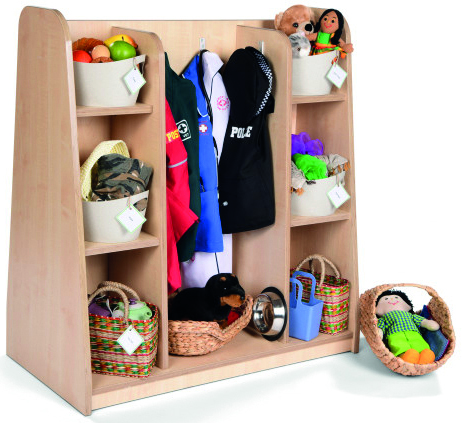
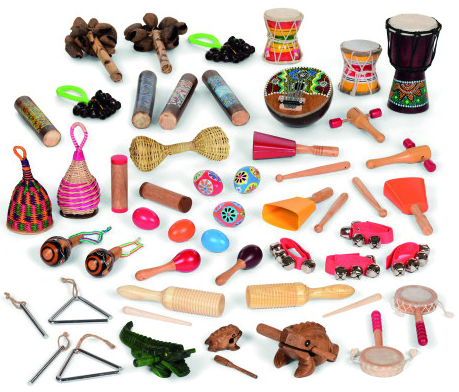
WHAT RESOURCES TO CHOOSE
When it comes to selecting materials to use for EAD, it is important to consider the children’s interests and how they have interacted with certain materials in the past.
‘It’s better to start with less and do it well’, McTavish advises. ‘This way, children can deepen their learning over time through a variety of quality experiences and activities.’
Suggestions of what to include in your EAD continuous provision include:
- A selection of quality mark-making materials: chunky crayons, chunky pencils, felt-tips, oil pastels. Allow children to safely use Biros and pencils or black or white markers.
- Decant powder paint in large tubs and show children how to mix their own colours with a visual prompt guide.
- Supply a selection of tools. For example, several types of scissors for different needs: sharp scissors that cut; scissors with springs for children who struggle with fine motor skills; and scissors with four holes for those who need adults’ support.
- Use recycled, reused and natural free-and-found materials where possible. Ask parents to donate cardboard, paper, bubblewrap, wrapping paper, string, wool, corks or curtain rings.
- When buying materials, think about what resources give the most options for creativity. For example, coloured pom-poms are limited, but tissue paper has many uses.
- Source open-ended materials that can be used in multiple ways. For example, a good supply of paper that can be cut down to different sizes.
- Materials for junk modelling, building and designing; collage; transient art and woodwork.
- For music, dance and movement, supply a basket of sturdy instruments, scarves to dance with, a source of different genres of music – and space to move.
- Resources for imaginative play: a home corner equipped with familiar and cultural items; role-play areas with fabric to create costumes; small-world play figurines and opportunities for story acting.
- Malleable play – sand, water, clay and dough – provide sensory, calming experiences and inspires children to express themselves imaginatively.
- Ensure that children have plenty of outdoor experiences linked to nature – weaving and large-scale art.
RESOURCES FOR EAD
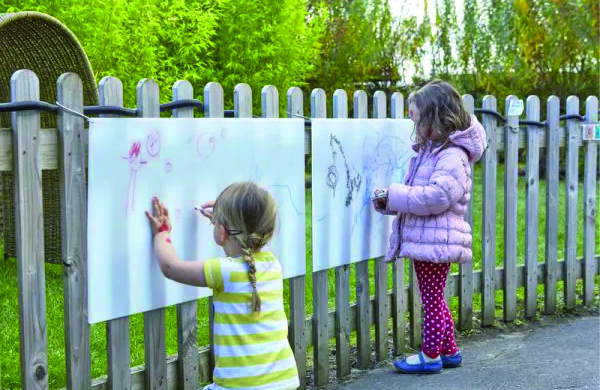 Education suppliers’ resource recommendations for developing children’s curiosity and creativity for EAD:
Education suppliers’ resource recommendations for developing children’s curiosity and creativity for EAD:
TTS’s Light and Colour Grab and Go Kit, £143.99, was designed to help children discover colour and light in intriguing ways. For exploration of sound, try the Sound Prisms Sensory Wooden Sound Blocks 12pk, £27.99, or the Grab and Go Early Years Percussion Instruments, £44.99. Outdoors, create large canvases with TTS’s set of four Outdoor Trundle Wheelie Painters, £84.99. Listen to music while you wheel with the TTS Wireless Outdoor Bluetooth Speaker, £119.99. Or for a quieter activity, children can enjoy small-world play with the TTS Outdoor Wall Dolls House, £219.99.
Early Excellence’s Music Resource Collection, £365, encourages children to explore their creativity though self-expression. Its Real Life Role Play Complete Area 3-4 Years, £835, is great for enriching imaginative play, and its Transient Art Resource Collection, £115, features open-ended resources to spark curiosity.
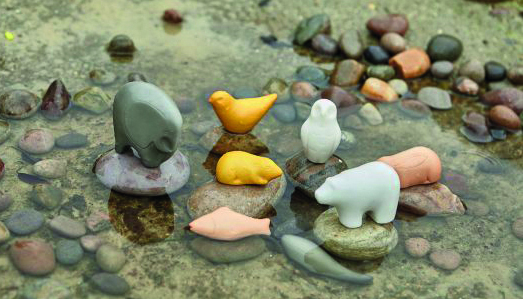 Hope’s Mark-making Classpack Kit, £109.99, can be used with paint or dough. For collage, textiles and craft projects, tryits Micro Flute Corrugated Sheets, £8.99; its Fabric Offcuts, £12.49, and its Stubby Chubby Paint Brushes, £13.99 for 12.
Hope’s Mark-making Classpack Kit, £109.99, can be used with paint or dough. For collage, textiles and craft projects, tryits Micro Flute Corrugated Sheets, £8.99; its Fabric Offcuts, £12.49, and its Stubby Chubby Paint Brushes, £13.99 for 12.
Cosy’s outdoor art materials allow children to express themselves on a large scale. Try the Fence Whiteboards, 2pk, £61.99 (pictured left, middle); the Wicker Weaving Wheels, £15.99 for 4 (left, bottom); the Long Reach Angled Brush, £1.29; and the Art Mark House, £695.
Yellow Door’s Natural Focus Frames, £25, made from certified beech wood, are great for transient art displays. It also has a range of small-world play sets. Try the Animal Friends – Sensory Play Sets (left, top), £22, a great springboard for imaginary play and storytelling. Use alongside the Little People – Sensory Play Set, £22.
CASE STUDY: Diggers Forest School in Petersfield, West Sussex
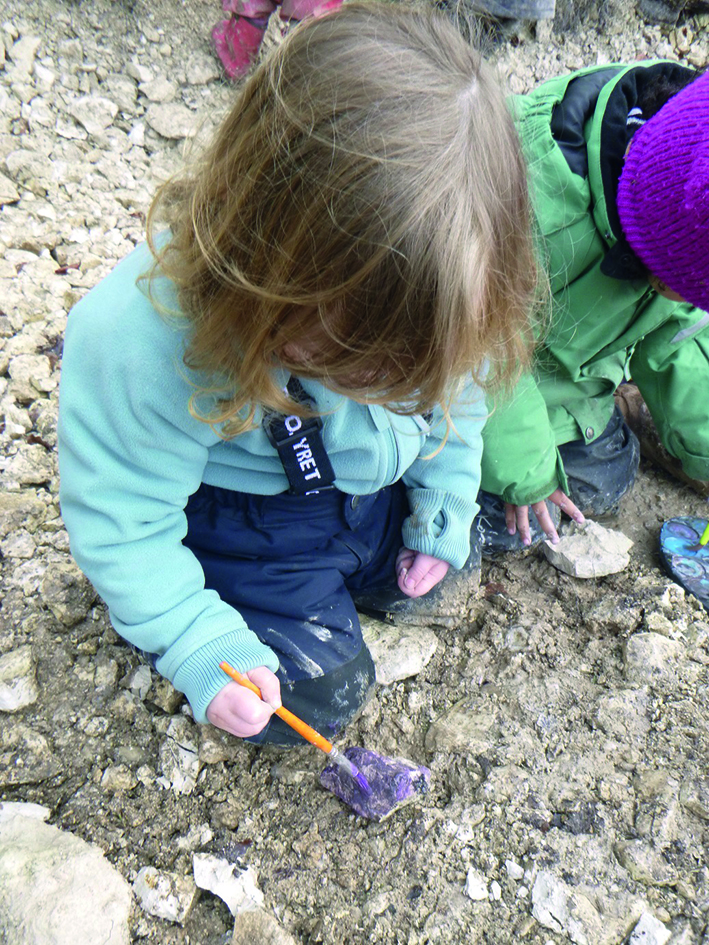 ‘Being a predominantly outdoor Forest School nursery, children are not tied to four walls, so they have the opportunity to express themselves creatively on a large scale,’ explains Sharon Bowell, manager at the 26-place setting.
‘Being a predominantly outdoor Forest School nursery, children are not tied to four walls, so they have the opportunity to express themselves creatively on a large scale,’ explains Sharon Bowell, manager at the 26-place setting.
‘Children’s imagination is at the heart of our EAD offering. They take the lead as we wander through our vast outdoor space, which consists of farmland, woodland, gardens and a pond. Their favourite activity is what they call the mine, an eight-foot-high fallen tree with meandering roots that they climb on to “mine” the natural chalk.
‘The chalk, which they collect from the roots and send down in buckets on a simple pulley system, becomes crystals and treasure, or they paint them with watercolours and create transient art patterns. They are deeply engaged in the process and we observe resilience as they climb up the tree, and teamwork as they load the buckets and lower them down to their friends. All the time they are communicating with each other and willing each other on to have a go.
‘For one little boy, who was quiet and preferred to watch from the sidelines, the natural chalk and the tree trunk was the start of his journey towards opening up. He had a keen interest in trains so one day, I took some chalk and on a smooth bark tree I drew a train track, asking myself, “I wonder if it has a narrow gage or a large gauge?” He came over and said, “It’s definitely not a narrow gauge,” as he demonstrated by placing his train on the train track and driving it around. Over the weeks we made train tracks out of twigs, drew them in charcoal and threaded leaves or conkers to become carriages. As his confidence grew, other children took an interest and he started to make friends and play games using his imagination.’
MORE INFORMATION
- Playing and Exploring by Anni McTavish
- ‘A Close Look at Expressive Art and Design’: podcast interview with Emma Jo Bairstow: https://earlyexcellence.com/eex-podcasts
- DfE on YouTube: https://bit.ly/3tuAlqC









